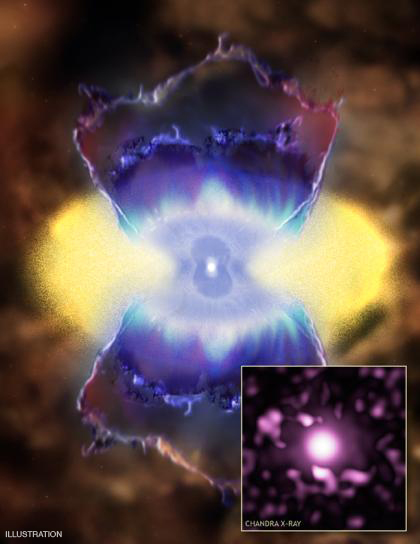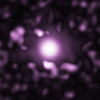Chandra Finds Evidence for Quasar Ignition

Credit: Illustration: NASA/CXC/M.Weiss; X-ray inset: NASA/CXC/U.Hawaii/A.Stockton et al.
An artist's illustration depicts a quasar in the center of a galaxy that has turned on and is expelling gas at high speeds in a galactic superwind. Clouds of hot, X-ray producing gas detected by Chandra around the quasars 4C37.43 (shown in the inset) and 3C249.1, provide strong evidence for such superwinds.
The X-ray features seen at five, six, ten and eleven o'clock in the 4C37.43 image are located tens of thousands of light years from the central supermassive black hole that powers the quasar. They are likely due to shock waves in the superwind.
Mergers of galaxies are a possible cause for the ignition, or turn-on, of quasars. Computer simulations show that a galactic merger drives gas toward the central region where it triggers a burst of star formation and provides fuel for the growth of a central black hole.
The inflow of gas into the black hole releases tremendous energy, and a quasar is born. The power output of the quasar dwarfs that of the surrounding galaxy and pushes gas out of the galaxy in a galactic superwind.
Over a period of about 100 million years, the superwind will drive most of the gas away from the central regions of the galaxy, quenching both star formation and further supermassive black hole growth. The quasar phase will end and the galaxy will settle down to a relatively quiet life.
|
||||||||||||||||||||||||||||
4C37.43 is a quasar, which is a powerful supermassive black hole in the center of a galaxy. The Chandra X-ray Observatory image (shown on the lower right) of 4C37.43 has bright purple and white colored intertwined splotches, with a glowing light in the center. In the main panel, an artist's illustration depicts a quasar in the center of a galaxy that has turned on and is expelling gas at high speeds in a galactic superwind. The structure of the quasar resembles that of a bright purple and yellow flower or a sunflower, with its petals spreading outwards from the center. This celestial object is known to be one of the most luminous objects in the universe, emitting vast amounts of energy due to the accretion of matter onto its supermassive black hole. Clouds of hot, X-ray producing gas detected by Chandra around the quasars 4C37.43 and another called 3C249.1 provide strong evidence for such superwinds. Stronger finger-like X-ray features seen at five, six, ten and eleven o'clock in the 4C37.43 image are located tens of thousands of light years from the central supermassive black hole that powers the quasar. They are likely due to shock waves in the superwind.




